There are special requirements for facade paint, and this is quite reasonable. After all, no one will be delighted with the need to annually redecorate the outer walls. That is why correctly selected, high-quality paint is a guarantee of the aesthetic and well-groomed appearance of the house for a long time.
Always pay attention to the composition of the paint. Its main component can be organic solvents (white spirit and the like) or water. In the first case, we are dealing with high weather resistance, the ability to use paint even in frost, but at the same time toxicity. Known varieties of such a coating are Effectplast, Luxe Masonry Paint, AK-124. Water-borne paints come in many varieties. They differ, first of all, in their intended use, as well as other factors:- Vinyl: Finncolor, Johnstones. Today they are not very popular, because they excessively absorb moisture, quickly get dirty, are susceptible to mold and mechanical damage. Their advantage is their low price.
- Acrylic: Ceresit, Triora, Aura Fasad Expo. Dust settles on such paint insignificantly, but it has low vapor permeability. Holds color well. Preferably applied to concrete or fiber cement boards.
- Silicone: Tikkurila, Ceresit. They practically do not absorb water, allow rain to flow down the wall and at the same time perfectly clean the facade. They have high vapor permeability: due to the porous structure of the coating, the house seems to be breathing. Lay on bricks, concrete, fiber cement boards, lime, cement, any old paint.
- Calcareous: CeboArt Pintura, Tikkurila. The paints are cheap, short-lived, mainly used for the restoration of buildings previously faced with lime plaster. Their undoubted plus is their disinfecting properties, which prevent the formation of mold and mildew.
- Silicate: Ceresit, SilColor, GreinPlast. They are able to withstand aggressive atmospheres and fungi. They have a modest palette, are difficult to apply, and can be removed with difficulty. Will not stick to acrylic or silicone surfaces. But they will perfectly fit on the same or lime paint.
- Cement: Tikkurila, Trampolino, Technocryl. Weatherproof, vapor permeable. They are applied on ceramic and silicate bricks, cement, lime, cement-lime and silicate plasters. Compared to lime paints, they are brittle, as a result of which they quickly peel off.
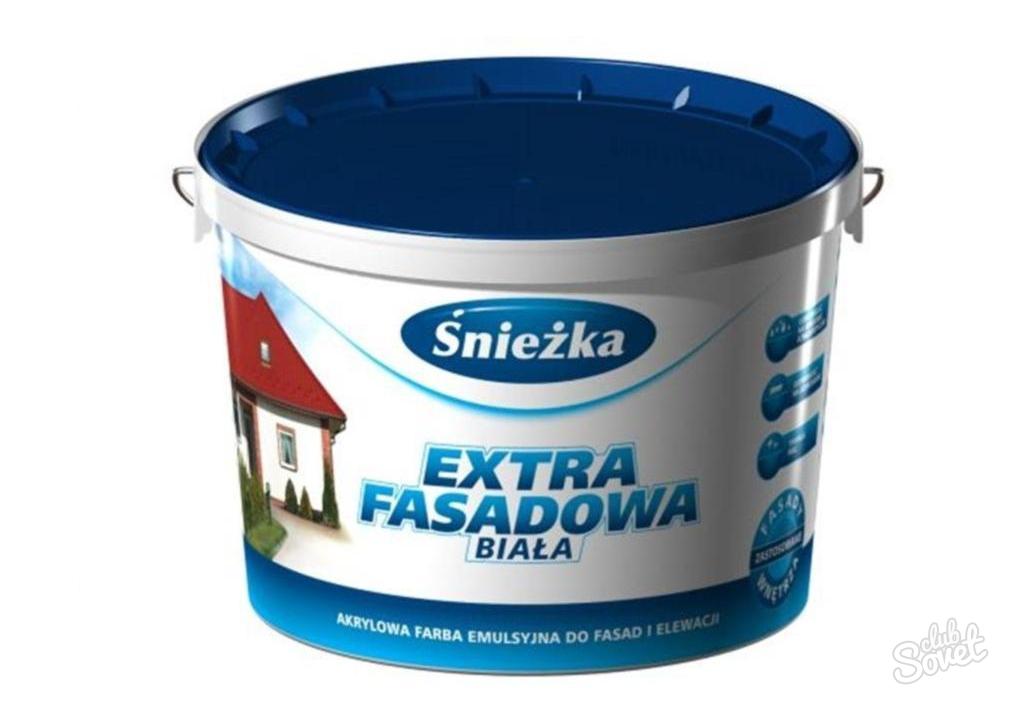
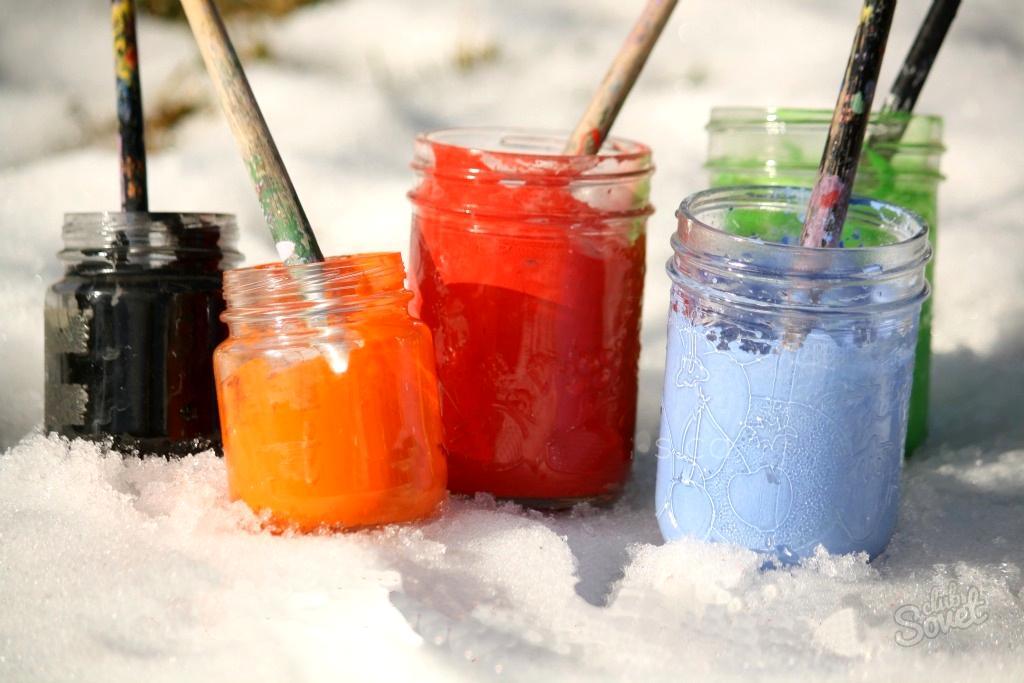

- grams / square meter (the optimal indicator is 130 and above);
- coefficient µ (1400-1500 units);
- Sd coefficient (0.11-0.05 and below).
![]()

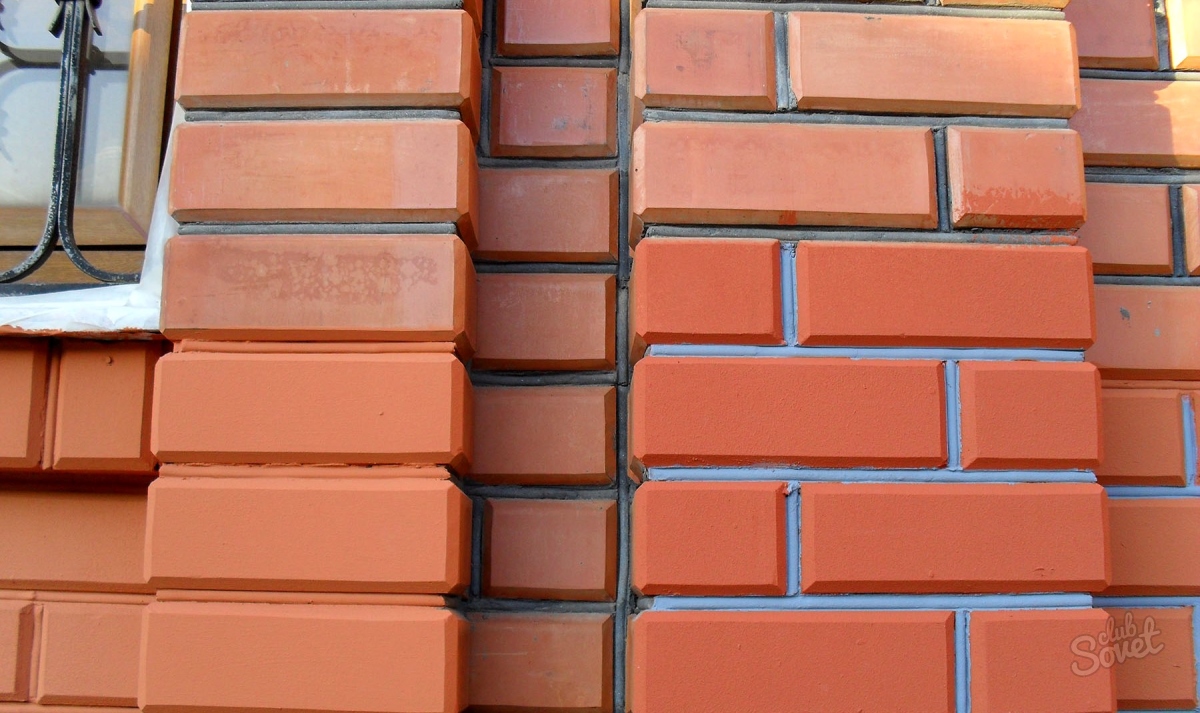
The packaging of a quality product should contain all the main indicators, including the consumption of the composition. When choosing a paint, do not trust only advertisements or the advice of the seller. Read all the information on the label, compare, take into account the type of base that you are going to paint. It is even better to use the recommendations of friends whose houses have looked perfect for more than one year.
High-quality painting of the facade of the building gives it a unique look and, moreover, allows you to acquire additional protection against negative impact environment and mask some defects on the surface of the walls. Right choice paint and varnish material for the facade is a guarantee that the house will acquire an attractive look for a long time. Therefore, you should know some of the requirements for facade paints.
Decorative and technical characteristics of facade paintwork
Tinting is the ability to obtain paint of the required shades by adding various dyes to the white base.
Lightfastness is the ability of a paint and varnish material to maintain its original life. long time without responding to exposure to sunlight.
Adhesion is an indicator of how much the material can interact with the treated surface.
Weather resistance b is an indicator of the material's resistance to negative atmospheric influences: humidity, precipitation, temperature changes.
Vapor permeability- the ability of the material to pass steam. When choosing a facade paint, it should be remembered that it should not allow water to pass through, but vapors must freely pass through it, since the accumulation of condensation under the coating layer has a destructive effect on the base.
Drying time, depending on the ambient temperature and the thickness of the paint layer.
Consumption - the amount of material required for processing 1 m². This indicator largely depends on the type of surface to be treated, the type of paintwork materials, the method of applying the material.
Criteria for choosing paintwork materials for the facade
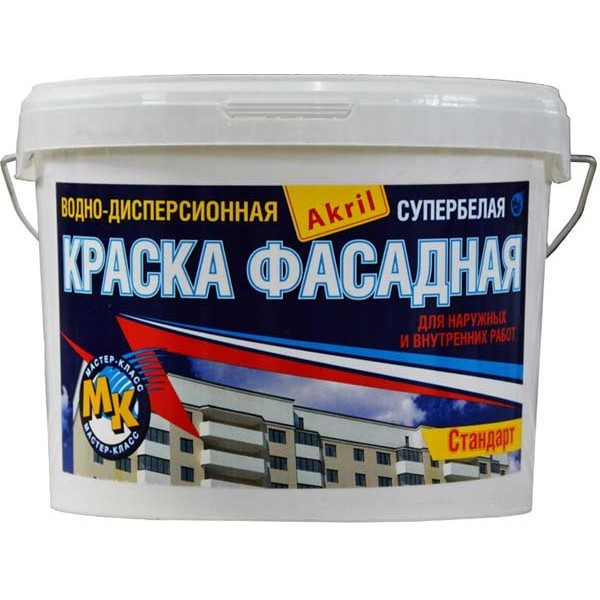
Most people who decide to paint the front of their home don't know how to actually choose the right paint. For a competent choice of a suitable composition and high-quality processing, you should adhere to some simple rules:
- one of the main criteria that must be taken into account is the type of surface to be treated;
- cost, since cheap material is not able to provide reliable protection and excellent appearance at home;
- before painting the facade, you should carefully prepare the surface and prime the walls, for which you should pay attention to the compatibility of the soil and the paint and varnish material;
- shelf life, which has a direct impact on the quality of the paint.
Choosing a facade paint
When choosing a facade paint, it should be borne in mind that for each type of surface there is a special paintwork material, endowed with unique characteristics. So, for example, a paint and varnish coating for brickwork should have high characteristics that are inherent in compositions for mineral surfaces - vapor permeability and good hiding power. Paintwork material for concrete must be resistant to alkaline environments and have high porosity.
There are the following main paint and varnish materials for facades:
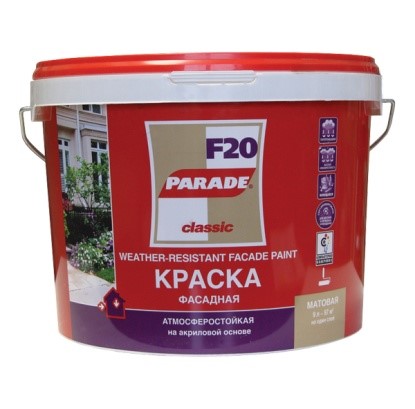
However, there are certain conditions for working with such formulations. So, for example, at the time of painting, the ambient temperature must be at least + 5˚C. Silicone paints should not be applied to crumbling surfaces and walls affected by mold and mildew. But after complete drying, you get a high-quality and durable paintwork.
- Paintwork for wooden facades picking up the hardest. This is due to the fact that wood absorbs moisture well, is prone to decay and is highly flammable. Therefore, when buying material for painting a house with a wooden facade, all these factors should be taken into account. The best option is a paint that has high elasticity, moisture resistance and good hiding power.
- For plastered facades... Such a composition should have a number of properties inherent in mineral surfaces, and when choosing, it is worth considering vapor permeability, moisture resistance, elasticity and hiding power.
All paints and varnishes are divided into compositions based on organic solvents and water soluble.
Water-borne facade paint
For painting facades, water-soluble paints and varnishes are most often used, which have the necessary gas and vapor permeability, fire resistance and odorlessness. Such paintwork materials, as a rule, are produced in white and can be easily tinted. In turn, water-soluble paints and varnishes can be dispersive, silicate and silicone.

Lime paint does not have good resistance to negative environmental conditions. Plastered, brick and concrete surfaces can be coated with a similar composition. Such a coating is very often used for painting facades, but it washes off or fades too quickly.
Dispersion paints are not resistant to mechanical and weather influences. Quite often, this type of paint and varnish material is subject to the formation of mold and the occurrence of fungal diseases.
Cement paint coatings are a mineral powder based on white Portland cement. Depending on the surface to be treated, the paint is diluted with water or a special solution. Such a coating quickly becomes dirty and is not able to protect the facade from the negative effects of moisture.
Organic compounds
Paints based on organic solvents have certain advantages over other paints and varnishes, namely: high quality surface treatment, good resistance to mechanical stress and low temperatures... However, there are also disadvantages in the form of high toxicity and flammability. To organic paints and varnishes include enamels and oil paints that are suitable for painting any type of surface. However, condensation is often created under the layer of such a coating, leading to surface cracking.

Adhesives are made from organic polymers such as cellulose, casein, starch and polyvinyl alcohol. Such paintwork materials create a matte and "breathable" coating, but are not recommended for painting facades due to their low moisture resistance.
Important ! Do not forget about priming the walls before painting. The primer allows not only to increase adhesion to the surface, but also to significantly reduce the consumption of paint and varnish material.
Consumption calculation
It is quite understandable that no one wants to incur unnecessary costs by buying paint in excess. To avoid this, it is enough to calculate exactly how much material is needed to paint the facade of the house. True, there are several nuances here.
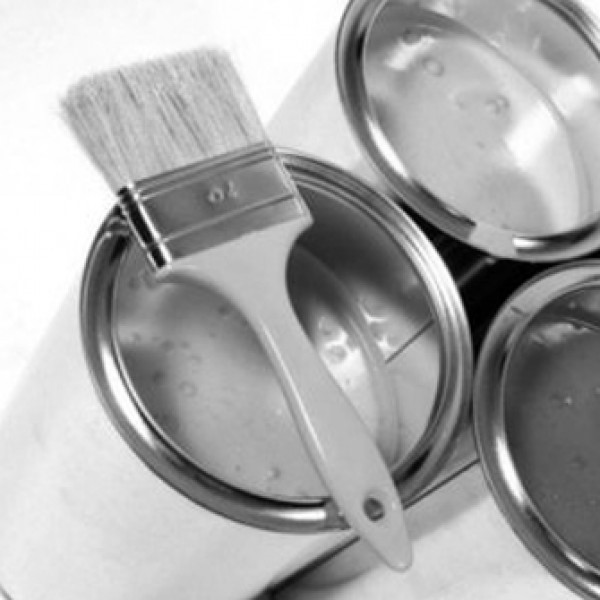
To more accurately calculate the consumption of material, the area of the facade should be multiplied by the amount indicated on the package per 1 m². If the packaging indicates that 1 liter jar is designed for 20 m², then 1000 ml: 20 m² = 50 ml / m², this will be the paint consumption per 1 m². Now we multiply the area of the facade by the calculated value and get the required volume of material for one layer.
The facade must be painted in at least two layers and, accordingly, the resulting volume of the coloring composition is multiplied by half. It should be borne in mind that the consumption per 1m² indicated by the manufacturer on the packaging was calculated for a perfectly flat, homogeneous and well-primed surface, optimal temperature and humidity. In real conditions, this is very difficult to achieve and therefore it is worth purchasing material 10% more than calculated. In addition, it is recommended to purchase a primer from the same manufacturer as the purchased paint.
The choice of facade paint is important. The paint determines the appearance of the house, its aesthetic perception. It also protects supporting structures from the damaging effects of the sun, precipitation, and wind.
There is also an important function of facade paint - not to prevent the walls from drying out from moisture coming out of the room. If the paint traps water vapor, the structures will lose their appearance, quickly deteriorate from moisture ...
There are many varieties of facade paint, you can "drown" in this variety. Facade paint is distinguished primarily by its base. The most popular are cement, silicone, silicate, and acrylic paints.
What to look for when choosing a facade paint?
The basic rule for the selection of facade paint
The choice of facade paint is primarily influenced by the base material on which it will be applied."What kind of plaster, such facade paint is applied" , - for example, cement-based paint is applied to cement plaster. This rule usually works well. The result is a durable, reliable façade surface.
But if there is a desire and need to take advantage of the results modern technologies and to get additional useful qualities of the facade surface, then you need to make a complicated choice of facade paint.
What surface qualities of the facade might be required?
For example, the following is popular:
- self-cleaning facade;
- biologically resistant coating;
- concealment of small cracks and chips on the base;
- bright not fading coloring;
- new surface texture, sun-reflecting coating, etc.
But above all, the coating on the facade must be vapor-permeable "breathable" for certain types of foundations;
Below is the compatibility table different types facade paints with a base.
Facade paint can be selected according to this table.
We will consider additional properties of facade paints that may be useful later.
Facade paint should not interfere with the "breathing" of the wall
If the facade paint significantly blocks the exit of steam from the wall to the outside, then this will lead to very serious consequences - waterlogging of structures, water accumulation in them. The appearance of mold on the facade and peeling of paint is the most harmless consequence of this ...If only vapor barrier materials are used in the wall structure, such as dense concrete and its dense varieties (cinder concrete ...), as well as brick, foam plastic, extruded polystyrene foam, foam glass, etc. then you can use facade paint with any resistance to steam movement.
But if the load-bearing wall is made of materials with high vapor permeability, such as porous ceramics, aerated concrete, large-porous expanded clay concrete, etc., or (and) insulation materials with high vapor permeability are used, such as mineral wool, aerated concrete, then the paint layer must be characterized as "with high vapor permeability".
Which paint will have high vapor permeability?
Manufacturers always give the vapor permeability characteristics for the finished facade paint layer of the recommended thickness. But there is no single standard for this characteristic. Therefore, either the air thickness Sd equivalent in terms of vapor permeability is indicated, or the penetration of water in grams into the surface layer of 1 m2. per day, or the reduced vapor diffusion coefficient m.
Accordingly, a paint layer is considered "with high vapor permeability" if:
- equivalent air thickness - no more than Sd = 0.1 m;
- water permeability through the surface - not less than 130 g / m2. days;
- coefficient of diffusion of water vapor m = 1400 - 1500.

Facade paints that hide cracks and irregularities
There are special thick paints, which can hide cracks up to 0.5 mm wide. They have polymer fibers added. The base is usually silicone, or polymer-silicone or silicate. As a result, the plaster covered with cobwebs of cracks is bonded on top with a durable coating and cracks are not noticeable.The next option is an acrylic base with a granulant filler,- textured paints. Such paints create a textured (textured) surface and well cover and mask minor irregularities of the facade, including the remnants of old paint and plaster chips.
Layer thickness - up to 1.0 cm.
This paint can be applied on fairly even, but not plastered walls, - on lightweight concrete blocks, which can achieve significant savings.
With such paints, you can create a special texture of the facade or textured patterns on the wall.
Another option for modern technologies is paints with nanoparticles, which collect at the surface of the layer forming a surface film. Such paints also easily hide cracks, scratches, small chips of the base on which they are applied.
Biosecurity walls
In places with high humidity, near water bodies, with a high standing of groundwater, fungi (mold) and mosses grow on the shaded side of the house.In such cases, acrylic paints with bioprotective additives will come to the rescue. But acrylic paints, although they have the brightest and most stable (non-fading) colors, usually have increased resistance to vapor movement. Therefore, they are not applicable in all cases.
Another practice is to use a primer for walls with the inclusion of antifungal agents. The effect can be enhanced by the introduction of such additives into ordinary "breathing" mineral paints for water based.
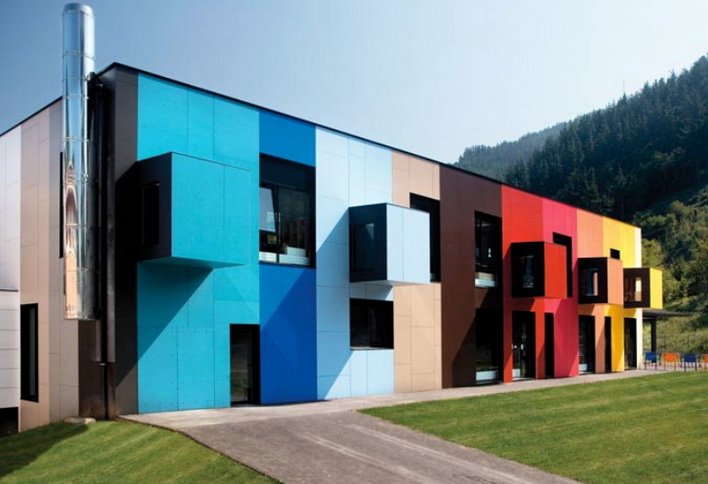
Self-cleaning facades
Facades of houses located closer than 50 meters from highways or streets with active traffic, as well as near polluting industries, are subject to rapid and significant pollution. Already after 2 - 3 months, the new facade in such places acquires a grayish tint from the dust settled and penetrated into the paint. Water drives dust into microcracks on the facade.The solution is to create a water-repellent surface on the facade. Then water and dirt will not penetrate under the top layer of the coating, and the facade will be able to retain its original appearance.
When water gets on such a surface, it does not linger on it, is not absorbed, but rolls down in drops. Even small precipitation that wetted such a wall completely wash away the dust from it.
Such a facade can be easily cleaned by washing it with a hose with water or a brush ...
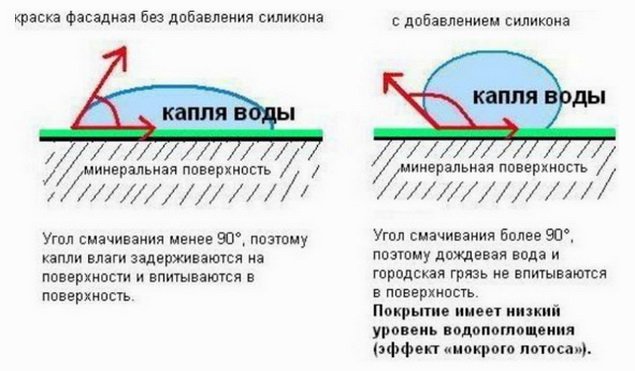
The self-cleaning (cleansable by rain) surface is created by silicone-based facade paints.
Or silicate and acrylic paints have similar properties, but with silicone and polymers.
But manufacturers often do not indicate such properties of products, apparently, purification is not yet popular with the consumer and does not generate demand.

Selection of the color of the facade paint
After there is a certainty with the type of paint and the required additional properties, it is necessary to solve a very difficult question of choosing a color.Only specialists, designers and architects will help to simplify the selection of colors for the facade. The facade of the house should be in harmony with the colors of the adjacent territory and buildings. At the same time, it should not be boring, plain monochromatic.
As a rule, the main color of the walls is accentuated by the contrast located at the entrance, and also complemented by another color (decor) scattered throughout the building, often associated with abutments and openings.
You can choose the color of the facade yourself, unless you copy it from the sample in the photo.
The task is to draw a palette of colors for the facade on paper. In comparison with it, the selection of the color of the paint will be made (selection of a standard shade under the number).
Cement, lime, silicate paints have the most limited selection of colors, mostly limited to pastel colors.
Silicone and acrylic paints, on the contrary, are distinguished by bright various shades.
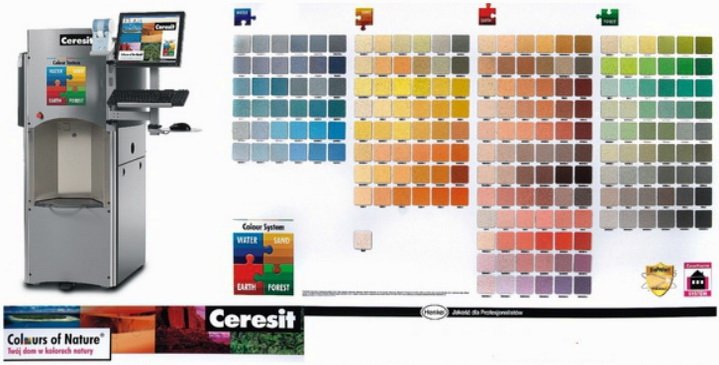
Tinting is carried out in large trading organizations on special tinting devices, where different colors are added to the original white paint base under computer control. The program determines the color and the number of tints to obtain the desired shade.
The shade of paint for the facade is selected from standard samples, each of which is assigned a number in the manufacturer's catalog. Having chosen a shade from the catalog that corresponds to the facade palette, in the future you can only name its number and the operator will make it again.
When deciding on the choice of a particular shade, you need to remember that dark and saturated colors on the facade will look even darker and more pronounced. Therefore, they often make two small batches of facade paint, but different in tone, and paint small fragments of the wall with them, then decide which color is best for a given building. Or they immediately make the paint a little lighter from the sample, which seemed to fit the palette.
The temperature in the room in which the cans are located cannot be lower than 5 ° C. They must be protected very carefully both from frost and from direct heating in the sun. Otherwise, the paint will change its physical properties: it will not have a uniform consistency, lumps will appear in it and it will become unusable.
It is very important that the container with the paint is tightly closed at all times, otherwise its contents will dry out. Sometimes it happens that in a jar that has been standing still for a long time, a thin layer forms on top of the paint, for example, resin, which looks like clear jelly... Don't worry about it. It is enough to mix the contents of the can thoroughly before use and the paint will become homogeneous.
Criterias of choice
Homeowners (especially those located on streets with heavy traffic or near an industrial area) often complain that the facades turn gray a few months after painting. Therefore, they are looking for products that are resistant to pollution.
There are no paints on which dirt does not settle, but there are ones thanks to which it does not absorb into the walls and is easy to wash off. These paints form hydrophobic films that are self-cleaning. As a result, dirt and moisture are not absorbed into the wall, but remain on its surface. They are easy to remove with water: they are usually washed off by rain.
The hydrophobic properties of the paint build up after coloring (it stabilizes after about 28 days). Silicone paints “repel” dirt best of all, acrylic and silicate paints modified with silicone polymers are good. Unfortunately, there is no information on the packaging about how high the resin content is in the paint (and this has a significant effect on the effectiveness of the paint), so it is better to use products that have been tested in practice by someone you know.
If, two years after painting, the facade remains clean and throughout this time retains its original color, it is worth purchasing a product of this particular brand.
Attention! When choosing a paint, pay attention to the degree of gloss: glossy ones are more resistant to dirt - rain will better wash away dirt from them. Another secret: on a surface painted with a darker paint, dust is less noticeable.
On the packaging of almost every paint there is information that it is vapor-permeable. Manufacturers do this in an effort to meet customer expectations: everyone wants their home to be “healthy” and to “breathe”.
There is one more nuance due to which this parameter is given such a value: the denser the outer shell of the facade is, the more inevitably condensation of water vapor will occur under it, which, as you know, moves from inside the house to the outside. As a result, paint may begin to flake off from the substrate. The likelihood of such an outcome is especially high if the base was not primed before painting.
Preparation of the base
So that the wall retains for a long time fresh look, it must be well prepared for painting. It doesn’t matter whether it’s a new home or renovating the façade of an old building - it’s always safer to use a primer first. The type of primer must be matched to the type of paint with which the facade will be painted.
The primer consists mainly of a binder (film former), so it is usually colorless. The undercoat will even out the water absorption capacity of the substrate and increase the adhesion of the paint. True, these are additional costs, nevertheless, they will certainly pay off, since the consumption of paint for the decorative layer will decrease, and, in addition, such a tool will facilitate staining.
Before priming, you need to check if the base is crumbling. It must be strong and dense, otherwise the paint will flake off. You can independently make a simple assessment of the bearing capacity of the base. A piece of transparent stationery tape is glued onto it and tear off after a minute. If there are no paint residues or base particles on the tape, it can be considered durable.
Fresh. It takes time between plastering and painting for the wall to dry completely. Typically, you will have to wait at least 30 days. If you start painting earlier, and on the wall, for example, lime plaster, then the lime will be aggressive towards the paint, and therefore it will not be possible to obtain a uniform color.
Old paint. Carefully check if old paint is peeling or bubbling. If peeling, it must be completely removed by scraping with a spatula and then rinsing off the remaining paint with water under pressure. Then a primer should be applied. If the old paint is in good condition, it is not necessary to prime it - it is enough to rinse it with water and, of course, wait until it is completely dry.
Next, the prepared facade is covered with finishing paint twice. It must be correctly matched to the type of solvent and binder, as the wrong combination can cause the paint to not adhere.
Color matching
Many manufacturers help to choose the paint by providing samples in which two or three colors are matched to the main color chosen for the walls for painting the elements of the facade. This makes the task much easier for people who have no experience in drawing up color combinations. You can also use a color palette (fan or color atlas).
If it is difficult to determine until the end which of the two favorite shades will look better on the facade (after all, the same color can look completely different in the shade and in the sun), you can buy or get a free sample of the selected paints and make a test on the facade of the house ...
Another tool in color matching is computer program, into which you can insert a photo of your own house and check how it will look with different colors of walls, roofs, windows and other facade elements.
If you choose a color on the example of a sample, buy a paint that is lighter than the one that you like the most, since on a large surface the color will appear slightly darker than on the sample. If, nevertheless, you cannot decide on a shade, then you can buy two large containers of paint of different tones. After painting a large surface, it will be easier to decide which tone to choose. Don't worry - the second coat of paint will completely cover the paint of a different shade, and the facade will be uniform.
Many developers, choosing a color scheme for the facade of their house, face difficulties: how to achieve a harmonious combination of all elements of the facade, to emphasize the individuality of the building and not oppose it to its surroundings? In a situation where the services of an architect are not available, experts recommend following a few simple and reasonable rules that will allow you to get a decent result when decorating a house:
- For painting the facade, it is better to choose a light pastel paint. Such a facade will harmoniously fit into the environment and it will be easier to match the color of the roof to it. In this case, monotony can be avoided by using two shades of the same color (for example, to emphasize window and door openings and other elements of the facade with paint of a lighter tone).
- As a rule, the color of the walls should be lighter than the color of the roof. Of course, the opposite option is possible, but its implementation requires a serious aesthetic justification and professional intervention of a designer and architect.
- If it is assumed that the facade will be multicolored, then when choosing colors and materials for finishing, one should look for a "common denominator" so that their combination is harmonious - this will allow to streamline any variety.
- Even the most dull facade can be revived and transformed if you skillfully highlight its details with color - window and door openings, balustrades, window layouts (spros), chimney, plinth, etc. It is worth taking advantage of this opportunity, not forgetting, of course, about the general stylistic unity.
- With the help of paint, it is possible to emphasize and mark the horizontal division of the facade, thereby changing the overall architectural impression of the object. For example, if the upper part of the house (roof and attic floor) is painted in a darker color than the lower one, the building will acquire features of solidity and massiveness. If the upper floor is lighter than the lower one, the building will appear taller and more graceful.
- It must be remembered that the building is inseparable from the external environment and therefore it is very important that the house does not fall out of the context of the general development and natural landscape.
The above visualizations of the project can serve as an illustration of the above.Murator М52а , demonstrating the variety of possible color solutions for the facade and roof, changing which radically change the architectural image of the building.
The appearance of the facade of a building largely determines its perception in an architectural ensemble or as a single building in a landscape. And the fastest, lowest cost and most effective method of completing a building or transforming an old building is to paint the facade. High-quality painting is a guarantee of the aesthetics of your home, it is able to protect the treated wall from the aggressive influence of negative weather factors. All paints for the facade of the house are specially designed for outdoor cladding, so they are sufficiently resistant and durable and can last for a long time.
Basic requirements for facade paints
The modern market offers all kinds of paints for painting the facade, that is, on a different basis. All of them differ in a number of properties from coloring compositions for interior work. The main task of outdoor painting is to withstand the aggressive effects of the external environment, while maintaining the integrity of the coating and high aesthetics.
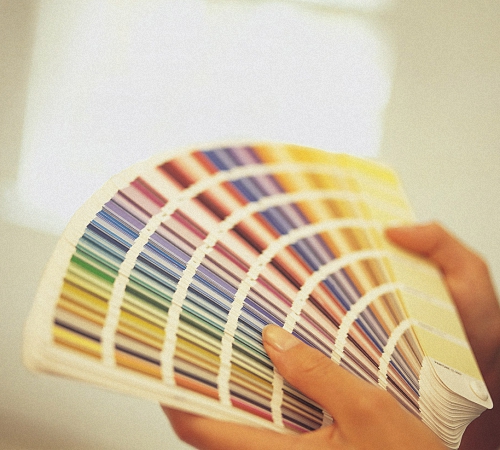
Choosing painting as the main means of renovating the facade, every consumer has the right to count on a durable and durable coating. But, to a greater extent, it does not depend on the quality of the facade finish with paint, but on its compliance with the applied surface. For all building materials and cladding, certain technical requirements, which they must comply with in several parameters:
1. Basic performance characteristics:
- resistance to temperature extremes and precipitation;
- resistance of the pigment to destruction from ultraviolet rays;
- vapor permeability - the ability to absorb and evaporate moisture without condensation;
- effective adhesion (adhesion to the treated surface, deep penetration into the pores of the building material);
- resistance to flaking and swelling;
- durability without peeling and discoloration.
- should not fade even on the south side of the house in warm climates;
- interaction of the pigment (the main dye in the composition) with sunlight, maximally revealing the selected color scheme;
- obtaining any other shade when adding a coloring pigment or filler;
- painting qualities of work (ease of application, easy distribution over vertical wall, the ability to level out after application);
- a pronounced property of light reflection - matte, glossy, semi-gloss and semi-matt paint.

3. Technological characteristics:
- low consumption of material per square meter of area, which depends on the type of surface and the method of painting;
- uniformity of distribution over vertical and inclined surfaces;
- uniformity - the absence of thick lumps and liquid bald spots during application;
- the possibility of high-quality painting in one layer;
- high rates of drying - due to the composition, thickness of the applied layer, the type of surface to be treated and the temperature of the external environment during operation;
- low toxicity (although it is always recommended to work with a respirator and protective clothing).
Attention: Any paint has a certain service life, so it is not able to retain its original attractiveness for decades. Over time, any facade has to be updated, but it is important that the new layer is fully compatible with the previous one. Check what paint was applied before!

The main varieties of modern facade paints
The specific visual effect of a building depends on the shade of the dye and its suitability for the overall artistic task. But to a greater extent, the appearance of the building is influenced by the uniformity of the application of the facade paint layer and its reflective properties - matte or glossy.
Today the market offers a large number of color variations of facade paints. But each of them has its own specifics, that is, each is designed for a certain type of surface and service life. Looking for better paint for the facade it is worth remembering that they are all about the same, this is a mixture:
- base or binder;
- coloring pigment silt color;
- other fillers and mineral additives.

The most common types are:
- silicate facade paints based on potash glass;
- silicone and silicone-modified paints;
- lime or mineral;
- polysilicon (silicate ash);
- silicone acrylic;
- silicone emulsion;
- latex or acrylic facade paints.
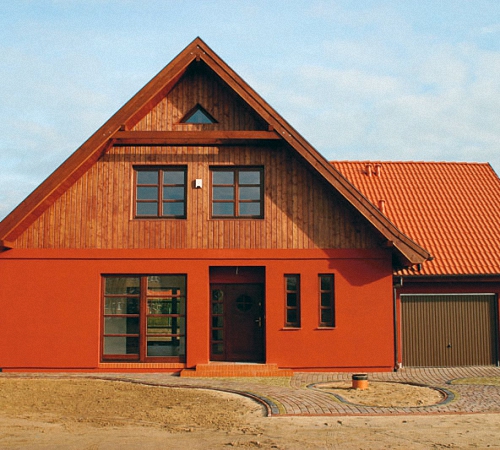
Most facade paints come in convenient packaging - plastic buckets. They are completely head-to-eat or require slight dilution for consistency. It can also be changed, depending on the layer, for example, the first is thicker or thinner than the second.
Facade paints are classified according to the groups of applied surfaces:
- for dyeing wood;
- for plastics and polymers;
- for concrete goods, concrete and brickwork;
- for a metal surface.
All paints differ in composition and type of solvent, for example, water-based paints, which are classified as:
- mineral paints;
- water-dispersed paints, with the addition of polymers.
Facade paints based on organic solvents are intended to be diluted with volatiles. chemical compositions such as xylene or white spirit. Their main advantage is the ability to apply at negative temperatures or in conditions of high humidity.
Attention: This type of facade paint is toxic, highly flammable, therefore it is important to observe precautions when working with these paint and varnish products.
Water-dispersion dyes for facades are produced in 4 varieties:
- acrylic;
- polyvinyl acetate (PVA);
- silicone;
- butadiene styrene.

Water-based dyes are the safest and most environmentally friendly, although they are produced with the addition of synthetic fillers, colors and binders. However, they can be applied at ambient temperatures down to 0 ° C, as they harden in the cold. But this type of facade dyes is non-flammable and non-toxic, often used as paint for wooden facades. They are water-repellent, highly durable and flexible, and give a durable film coating that can be cleaned or washed. These dyes can be applied in layers until the desired effect is obtained.
Other types are also produced, for example, textured paint "Tikkurila" for facades, which forms a polymer film of increased durability. It gives the building a special unique look, thanks to its specific structure.
The rest of the varieties are not designed for facade decoration, although they are also used for external work - alkyd, oil, etc. Specialized paints are also produced for MDF facades and for external work on metal, which require surface treatment with a special primer. But they are less commonly used, have fewer pigment varieties, and are a little more difficult to work with.
Tip: Do not rush to buy facade paint of your favorite shade if it is not suitable for your surface in composition, purpose and type of surface. Today you can pick up any color scheme or pigment from catalogs. Approach the choice of dye responsibly so that you get a high-quality and durable coating that will be able to last more than 10-25 years, depending on the period specified in the instructions.
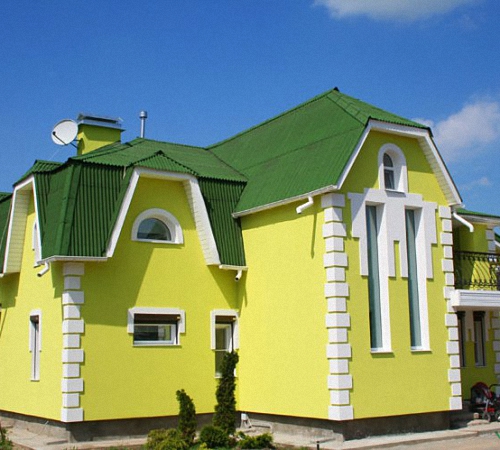
Characteristic properties of the main varieties of facade paints
1. Today the most demanded acrylic paint or latex, based on resinous substances. This dye is considered versatile and easy to work with. Acrylic-based paint is sufficiently resistant to environmental influences, not reacting to precipitation and temperature extremes. Such a facade is easy to maintain, since the layer of this paint repels dirt and dust well. However, latex facade paints are not used on silicate and limestone walls. Concrete or reinforced concrete products are most suitable for this type of facade paint.
2. Mixed type of silicone-acrylic facade paint combines the properties and advantages of two types of facade emulsions. This is the "golden mean", a composition that is perfectly distributed over most types of surfaces. They are distinguished by a long period with flawless operation.
3. Water-based silicone emulsion paints with the addition of silicone resin. It has the advantages of both types of dyes. High vapor permeability makes it possible to use it not only for outdoor work, but also inside buildings with weak foundation waterproofing. They do not contribute to the development of microorganisms, fungi, mold. The binder is an organosilicon resin, which looks very natural after processing. The texture resembles a dense, beautiful film with a matte surface. In addition, this facade paint produces a film that is impervious to damp environments.
4. Mineral facade paints contain lime and cement. They are classified as environmentally friendly materials, moreover, they noticeably differ from analogues in their low cost. Suitable for most types of exterior walls. Lime facade paint on a mineral basis is distinguished by high vapor permeability, that is, it accepts and evaporates water well, but does not like long "slanting" rains. Recommended for processing plastered concrete walls, brickwork. Not suitable for wood and metal.
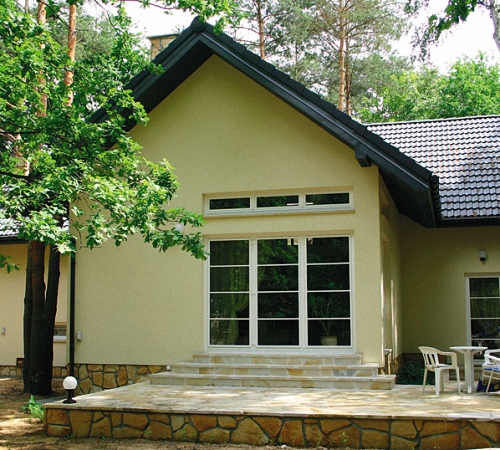
5. Silicate facade paints are produced on the basis of liquid silicate glass with the inclusion of organic additives. They have a lower water-repellent index, but they pass air and steam well. Silicone paint for facades is quite durable, does not fade, but fades over time. It fits well on the prepared surface - after plastering. It is not contaminated during operation. Only this variety is used on limestone blocks.
6. Silicone-modified paints belong to the category of dyes last generation with excellent adhesion. It is known for its high vapor permeability and UV resistance. This facade paint forms a durable film that does not lose color and integrity under the influence of the external environment and direct sunlight. Its film coating dries quickly with the lowest surface tension, without microcracks. Silicone-modified acrylic-based facade paints are used on old and problematic surfaces, therefore they are recommended for the restoration of architectural ensembles.
7. Polysilicon or silicate ash paint for facades is a modified version of silicate dyes. It is much more expensive than its predecessors, but it has improved characteristics. The only drawback is an unpleasant smell when working with it, but it quickly evaporates from the dried surface of the walls.
Attention: The basic rule when choosing a facade paint is the correspondence of the base material to the components of the dye!
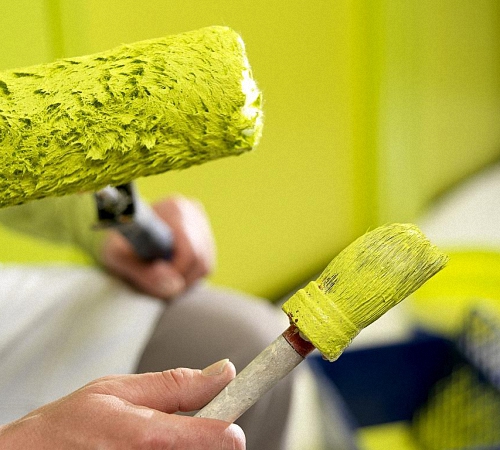
Dispersion paint and other types of dyes are not fully adapted for facade work, but sometimes they are also used outside buildings. It is less resistant to weather conditions, therefore it can be recommended only for covered verandas and terraces. In a climatic zone with high humidity, moss, fungus or mold grows on such a surface over time.
Tip: On complex facades that combine concrete products, metal, aluminum glazing, wooden parts and plaster moldings, it is better to use a universal facade paint. You will first need to treat all types of surfaces with specialized primers. You can also recommend the selection of paints of different composition but general color.
Methods for applying facade paint to various surfaces
Facade paint, with rare exceptions, cannot be applied to an unreinforced or unprepared surface. be sure to perform step-by-step preparation:
- cleaning the surface from the old layer, dirt and crumbling particles;
- strengthening the surface layer (if required);
- elimination of defects and sealing cracks;
- plastering (if it involves a surface);
- padding;
- painting.
Painting is applied in the way indicated in the instructions:
- roller;
- wide brush;
- manual spray gun;
- machine for painting facades.
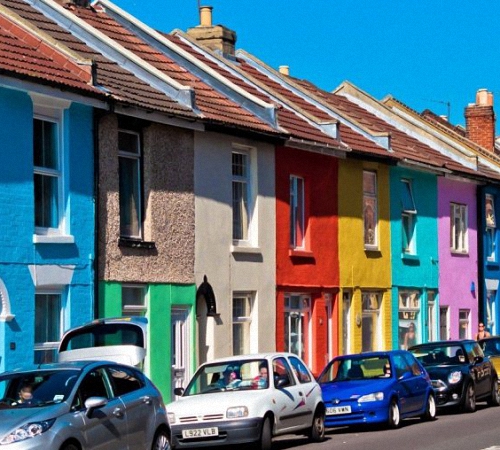
A little about safety when working with facade paint
1. All tools for facade work must first be checked for serviceability and integrity of all connections.
2. When starting to work, put on work overalls and gloves, protect the head, eyes and nasopharynx. It is preferable to wear shoes with thick and non-slip soles.
3. A reliable ladder is used to move along a one-story building, and mounting, safety or climbing equipment is used on the sheer walls of multi-storey buildings. It is forbidden to work in windy weather when the hanging paint cradle is swinging violently!




